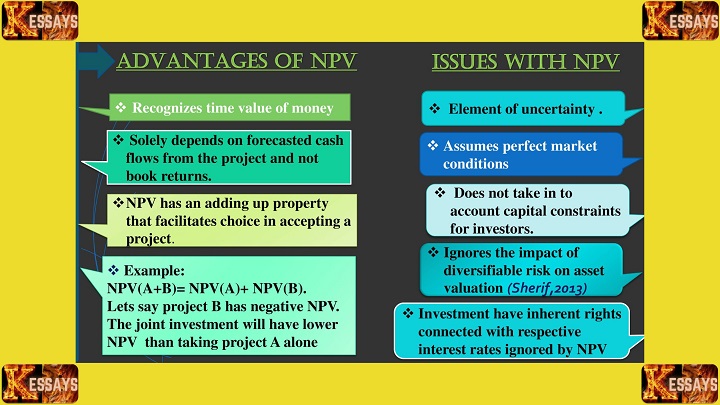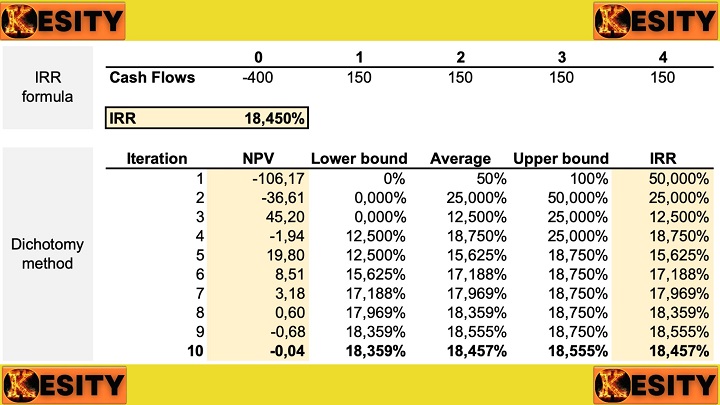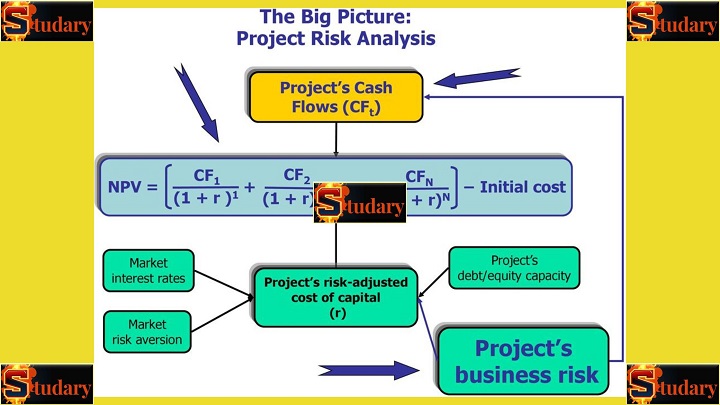Introduction
In the world of finance and investment analysis, understanding fundamental concepts like Net Present Value (NPV) and Internal Rate of Return (IRR) is essential for making informed decisions. For students seeking 'NPV and IRR Assignment Help,' this comprehensive guide aims to provide insights into NPV and IRR, explore their practical applications, and offer assistance with assignments related to NPV and IRR.
We will also delve into why NPV and IRR may provide conflicting decisions for mutually exclusive projects, how to choose between projects using NPV and IRR, and the factors that can lead to differences in rankings between these two methods. Additionally, we will discuss 'Npv assignment help examples,' 'NPV calculators,' 'IRR formulas,' and more to enhance your understanding of these crucial financial concepts.
1. Resolving NPV vs. IRR Conflicts in Mutually Exclusive Projects
In the realm of financial analysis, the interplay between Net Present Value (NPV) and Internal Rate of Return (IRR) is critical when assessing the viability of investment projects. However, complexities arise when NPV and IRR produce conflicting decisions, particularly in the context of mutually exclusive projects. This guide delves into the intricacies of these scenarios, highlighting why conflicts occur and offering techniques to harmonize divergent results and make informed investment choices.Understanding NPV vs. IRR Conflicts:
- Why NPV and IRR Conflict: Discrepancies between NPV and IRR evaluations stem from contrasting assumptions regarding cash flow timing and reinvestment rates. NPV assumes reinvestment at the cost of capital, whereas IRR assumes reinvestment at the IRR itself, setting the stage for conflicting project assessments.
- Timing of Cash Flows: A primary reason for NPV vs. IRR conflicts lies in the timing of cash flows. When cash flows occur disparately in the project's life cycle, the influence on NPV and IRR calculations differs, leading to incongruous decisions.
- Reinvestment Rate: Dissimilar reinvestment rate assumptions further contribute to conflicts. NPV employs a fixed reinvestment rate (the cost of capital), while IRR envisions reinvestment at the project's internal rate. These differences can result in projects being ranked differently.

Resolving NPV vs. IRR Conflicts:
- Additional Analysis: To reconcile conflicts, consider conducting supplementary financial analyses. Calculate the NPV and IRR of projects using diverse reinvestment rates and timeframes. This approach aids in identifying the project with consistent favorable outcomes.
- Sensitivity Analysis: Employ sensitivity analysis to gauge the effect of varying reinvestment rates and project durations on NPV and IRR. This analysis provides insights into the potential range of outcomes and aids in the decision-making process.
- NPV Preference: In cases of conflicting results, favoring NPV is often advisable. NPV is perceived as a more dependable metric because it assumes reinvestment at the cost of capital, a practice that aligns with the opportunity cost of capital in most investment contexts.
- Risk Assessment: Evaluate the risk associated with each project. Opt for the project with a higher NPV and a lower IRR if it offers more stable and predictable returns, especially when navigating uncertain economic conditions.
Read Also: Net Present Value Assignment: Calculation, Formulas, and Examples
2. Deciphering Discrepancies in Project Rankings by IRR and NPV
Net Present Value (NPV) and Internal Rate of Return (IRR) are pivotal metrics in investment analysis. They help assess the profitability and desirability of projects. However, it's not uncommon for these metrics to rank two projects differently, which can create a conundrum for investors and financial analysts. This section explores the reasons behind such disparities, delves into the factors influencing these variations, and provides strategies to interpret and address inconsistent project rankings.Analyzing Discrepancies in Project Rankings:
- Divergent Cash Flow Patterns: One of the primary reasons for IRR and NPV disparities is the unique cash flow patterns of each project. IRR focuses on the point where the net present value of cash flows becomes zero. If one project has early positive cash flows and the other has late inflows, this difference can lead to conflicting rankings.
- Reinvestment Assumptions: Variations in reinvestment assumptions are another contributing factor. IRR assumes that all cash flows are reinvested at the project's internal rate, while NPV assumes reinvestment at the cost of capital. This difference can lead to differing results, especially when the cost of capital is not equal to the project's IRR.
- Magnitude of Cash Flows: The magnitude of cash flows can also play a role. IRR is sensitive to the magnitude of cash flows, and large intermediate cash flows can create multiple IRRs, making interpretation challenging.
Strategies for Interpreting and Dealing with Disparities:
- Consider Project Scale: When projects vary significantly in scale, NPV may provide more reliable results. Smaller projects might have more competitive IRRs due to their size but lower NPVs, making NPV the preferred metric for ranking.
- Sensitivity Analysis: Conduct sensitivity analyses to assess how changes in key variables, such as discount rates and cash flow timing, affect IRR and NPV rankings. This approach helps identify the scenarios where projects rank differently.
- Scenario Analysis: Use scenario analysis to explore a range of potential future scenarios. Assign different reinvestment rates and assess the impact on project rankings. This method enhances the understanding of the projects' performance under various conditions.
- Risk Assessment: Evaluate the risk associated with each project. Projects with more consistent and predictable cash flows may be preferable, especially when uncertainty is a concern.
3. Project Selection Criteria: NPV vs. IRR
Choosing the right project is a critical decision in the world of finance and investment. Net Present Value (NPV) and Internal Rate of Return (IRR) are two indispensable metrics that guide these choices. This section delves into the decision criteria for selecting projects using NPV and IRR as evaluation metrics. It also highlights scenarios where one metric proves more suitable for making investment decisions than the other.Decision Criteria for Project Selection:
- NPV - Maximizing Value: NPV is a measure of the absolute value created by a project. A positive NPV indicates that a project is expected to generate more cash than it consumes, adding value to the investor's wealth. Therefore, when the primary goal is to maximize the wealth of shareholders or investors, projects with higher NPVs are preferred.
- IRR - Relative Returns: IRR represents the rate of return a project offers. It indicates the project's ability to generate a return that exceeds the required rate of return (typically the cost of capital). Investors opt for projects with IRRs higher than their required rate, as these projects deliver returns above the minimum acceptable benchmark.
- Independent Projects: When evaluating independent projects, NPV and IRR often lead to the same selection choice. Positive NPV and IRR greater than the cost of capital both indicate a favorable investment.
Situations Favoring NPV for Decision-Making:
- Multiple Project Options: In cases where multiple mutually exclusive projects are available, NPV is a more reliable metric for selection. It considers the absolute value added to the investor and helps rank projects by the magnitude of their value contribution.
- Varying Investment Levels: When projects require different initial investments, NPV provides a clearer picture of the wealth created per unit of investment. This makes it easier to choose projects based on maximizing value per dollar invested.
Situations Favoring IRR for Decision-Making:
- Budget Constraints: In situations where budget constraints are stringent, IRR can be the preferred metric. It highlights projects offering the highest returns relative to their investment, helping to prioritize projects within budget limitations.
- Opportunity Cost Considerations: IRR is particularly useful when investments require the allocation of limited resources or when there are attractive alternative investment opportunities. It allows investors to focus on projects with returns exceeding their required rate of return.

4. Calculating IRR Alongside NPV
Calculating the Net Present Value (NPV) and the Internal Rate of Return (IRR) together provides a robust approach to evaluating investment opportunities. This guide offers a step-by-step method for simultaneously determining IRR and NPV, empowering investors and financial analysts to make well-informed investment decisions. It also illustrates how NPV and IRR complement each other in assessing the attractiveness of investment projects.Step 1: Cash Flow Estimation
To calculate both IRR and NPV, you must first estimate the project's cash flows. These include initial investments, operating revenues, and expenses over the investment's lifespan. Ensure you have a clear understanding of the cash flows' timing and magnitude.Step 2: Calculate NPV
- Use the formula for NPV: NPV = Σ (Cash Flow / (1 + r)^t), where Σ denotes the sum of all time periods (t), r represents the discount rate (usually the cost of capital), and Cash Flow is the cash flow at each time period.
- Sum the NPV formula for each cash flow over the project's duration to obtain the total NPV. A positive NPV indicates that the project adds value to the investor.
Step 3: Iteratively Calculate IRR
- Set up an iterative process to calculate IRR. Since the IRR is the discount rate at which NPV equals zero, you need to solve for the discount rate that makes the NPV zero.
- Start with an initial guess for the discount rate (r). Common spreadsheet software can perform this calculation using built-in functions. Alternatively, financial calculators can assist in solving for IRR directly.
- Adjust the discount rate iteratively until NPV equals zero. The rate at which NPV becomes zero is the IRR.
Step 4: Comparing IRR and NPV
- Examine the IRR and NPV results. If IRR is greater than the required rate of return (typically the cost of capital), the project is considered attractive as it offers a return higher than the minimum acceptable benchmark.
- Assess the NPV value. A positive NPV indicates the project adds value, while a negative NPV suggests it may subtract value. The higher the NPV, the more value the project creates.
- Use both metrics in tandem. If IRR is above the cost of capital and NPV is positive, the project is likely a sound investment. If IRR is below the cost of capital but NPV is still positive, consider the project carefully. If both metrics are negative, it may not be a favorable investment.

6. Real-World Scenarios with Differing NPV and IRR Outcomes
In the realm of financial analysis and investment decisions, it's not uncommon to encounter scenarios where Net Present Value (NPV) and Internal Rate of Return (IRR) offer conflicting insights. This guide delves into real-world scenarios where NPV and IRR provide different outcomes, offering a comprehensive understanding of why this happens and how to navigate the resulting implications. By exploring such cases, investors can better prepare for real-world situations where divergent metrics influence investment choices.Scenario 1: Uneven Cash Flows
One common scenario leading to differing NPV and IRR outcomes involves projects with uneven cash flows. For example, a project might entail significant upfront costs followed by substantial revenue inflows in the distant future. While NPV accounts for the time value of money and discounts these future cash flows, IRR assumes reinvestment at the project's rate of return, potentially leading to divergent outcomes. Implication: Investors should recognize that projects with uneven cash flows may produce conflicting results. When faced with such scenarios, it's essential to consider both NPV and IRR alongside other metrics to make informed investment decisions.Scenario 2: Mutually Exclusive Projects
Another scenario arises when comparing mutually exclusive projects. NPV and IRR may offer contrasting rankings for different projects, making it challenging to determine the superior choice. This occurs when projects have varying cash flow patterns and investment requirements. Implication: In cases of mutually exclusive projects, investors should look beyond NPV and IRR, considering additional factors such as project size, risk, and strategic alignment with organizational goals. A thorough assessment is crucial to choose the most suitable investment.Scenario 3: Varying Project Durations
Differences between NPV and IRR can emerge when evaluating projects with varying durations. For instance, one project may have a shorter investment horizon, while another extends over a more extended period. IRR favors projects with shorter durations, as it assumes reinvestment at the IRR rate. Implication: When dealing with projects of varying durations, it's vital to acknowledge the bias of IRR towards shorter projects. NPV, accounting for reinvestment at the required rate, provides a more balanced evaluation, allowing for better-informed decisions.Scenario 4: Project Scaling
In certain situations, scaling a project can lead to divergent NPV and IRR outcomes. Expanding a project may affect the IRR, as it changes the magnitude and timing of cash flows. While NPV adjusts for scaling, IRR might be impacted due to changes in the project's structure. Implication: When contemplating project scaling, investors should analyze the potential effects on NPV and IRR. A holistic assessment should encompass the impact of scaling, costs, and benefits to make comprehensive investment choices. Real-world scenarios often present cases where NPV and IRR deliver differing results. These discrepancies are primarily driven by the assumptions and methodologies underlying each metric. By understanding the implications of such differences, investors can make more informed investment decisions and select projects aligned with their financial objectives and organizational strategies.Read Also: Project Selection Methods: NPV, IRR, & Payback Period
Best NPV and IRR Assignment Help Websites
When seeking assistance with NPV and IRR assignments, it's crucial to find reliable resources that can provide valuable support. Here are some of the top websites that offer NPV and IRR Assignment Help:- kessays.com: Known for its professional academic assistance, kessays.com provides guidance and solutions for NPV and IRR assignments.
- peachessay.com: Peachessay.com is a reputable platform that offers expert help for NPV and IRR assignments, ensuring students receive quality support.
- kector.com: Kector.com is a trusted source for academic guidance, including assistance with NPV and IRR assignments.
- mysassignmenthelp.com: Mysassignmenthelp.com is a reliable website that specializes in providing support for NPV and IRR assignments.


Comments are closed!